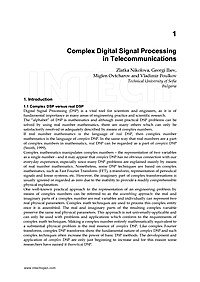
Complex Digital Signal Processing in Telecommunications
Digital Signal Processing (DSP) is a vital tool for scientists and engineers, as it is of fundamental importance in many areas of engineering practice and scientific research. The "alphabet" of DSP is mathematics and although most practical DSP problems can be solved by using real number mathematics, there are many others which can only be satisfactorily resolved or adequately described by means of complex numbers. If real number mathematics is the language of real DSP, then complex number mathematics is the language of complex DSP. In the same way that real numbers are a part of complex numbers in mathematics, real DSP can be regarded as a part of complex DSP (Smith, 1999). Complex mathematics manipulates complex numbers - the representation of two variables as a single number - and it may appear that complex DSP has no obvious connection with our everyday experience, especially since many DSP problems are explained mainly by means of real number mathematics. Nonetheless, some DSP techniques are based on complex mathematics, such as Fast Fourier Transform (FFT), z-transform, representation of periodical signals and linear systems, etc. However, the imaginary part of complex transformations is usually ignored or regarded as zero due to the inability to provide a readily comprehensible physical explanation. One well-known practical approach to the representation of an engineering problem by means of complex numbers can be referred to as the assembling approach: the real and imaginary parts of a complex number are real variables and individually can represent two real physical parameters. Complex math techniques are used to process this complex entity once it is assembled. The real and imaginary parts of the resulting complex variable preserve the same real physical parameters. This approach is not universally-applicable and can only be used with problems and applications which conform to the requirements of complex math techniques. Making a complex number entirely mathematically equivalent to a substantial physical problem is the real essence of complex DSP. Like complex Fourier transforms, complex DSP transforms show the fundamental nature of complex DSP and such complex techniques often increase the power of basic DSP methods. The development and application of complex DSP are only just beginning to increase and for this reason some researchers have named it theoretical DSP. It is evident that complex DSP is more complicated than real DSP. Complex DSP transforms are highly theoretical and mathematical; to use them efficiently and professionally requires a large amount of mathematics study and practical experience. Complex math makes the mathematical expressions used in DSP more compact and solves the problems which real math cannot deal with. Complex DSP techniques can complement our understanding of how physical systems perform but to achieve this, we are faced with the necessity of dealing with extensive sophisticated mathematics. For DSP professionals there comes a point at which they have no real choice since the study of complex number mathematics is the foundation of DSP.




















